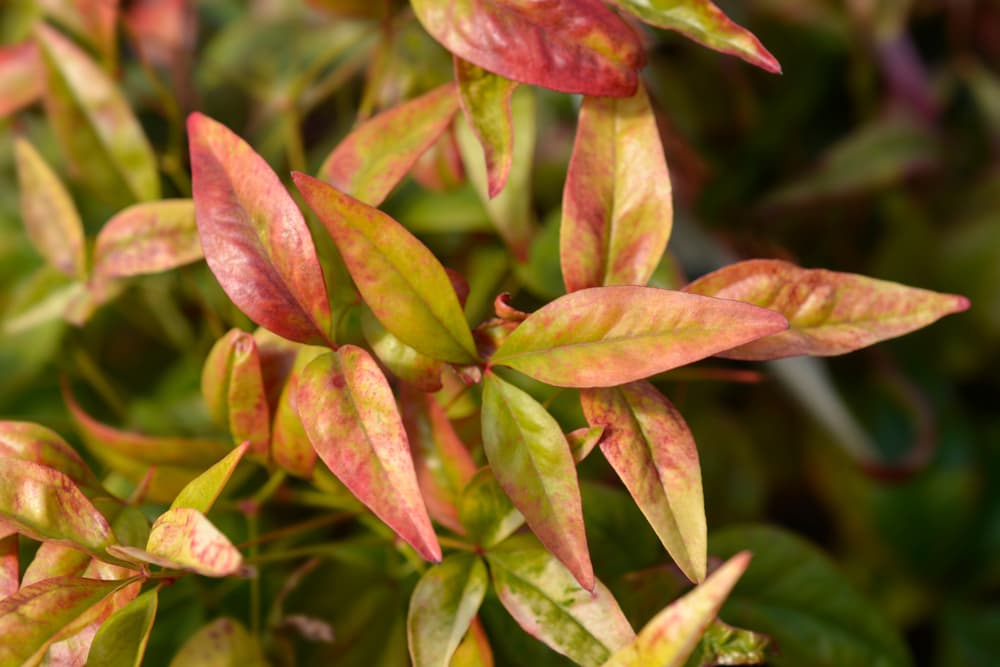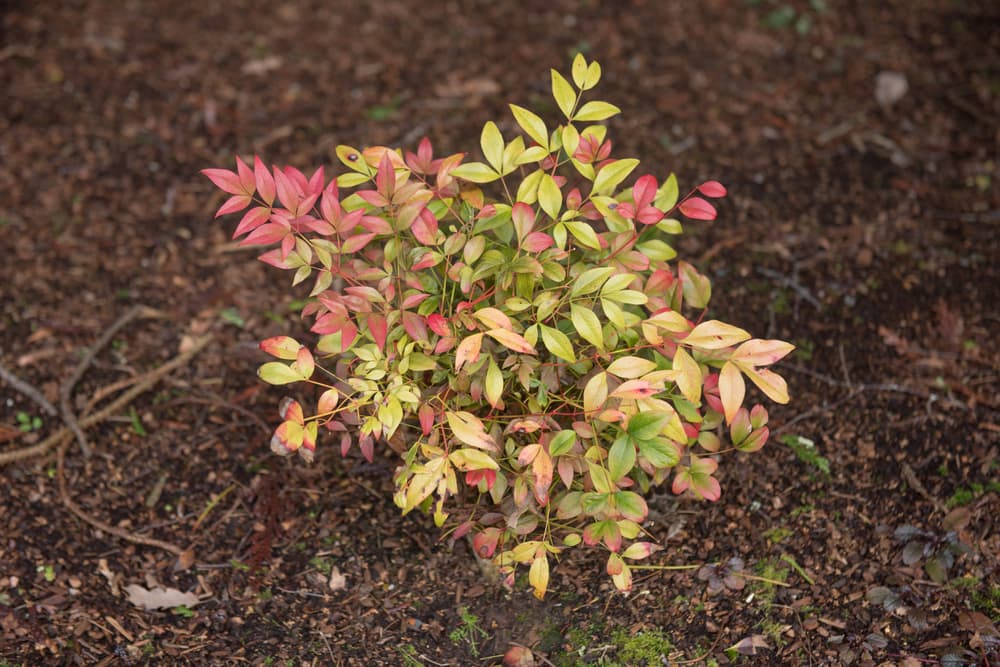SHRUBS > NANDINA
Reviewed By COLIN SKELLY

Colin is a Horticulturist and Horticultural Consultant with experience in a range of practical and managerial roles across heritage, commercial and public horticulture. He holds the Royal Horticultural Society’s Master of Horticulture award and has a particular interest in horticultural ecology and naturalistic planting for habitat and climate resilience.
IN THIS GUIDE
NANDINA GUIDES
Nandina domestica is an evergreen shrub, characterised by clusters of small white flowers, bright red berries, and pinnate leaves that turn red or purple in late autumn and winter.
This bushy shrub makes an attractive, dramatic addition to a UK garden, whether in borders, as part of a rock garden, or grown in containers.
Wherever it is positioned, it will add a touch of the exotic, and provide welcome winter colour.
The plant is winter hardy, and tolerant of high and low temperatures, making it easy to grow in the UK climate.
Once established, it requires very little pruning or ongoing care and therefore makes for an easy, ornamental addition to your garden.
Overview
| Botanical Name | Nandina domestica |
| Common Name(s) | Heavenly Bamboo, Sacred Bamboo |
| Plant Type | Shrub |
| Native Area | China and Japan |
| Hardiness Rating | H5 |
| Foliage | Evergreen, lance-shaped leaflets |
| Flowers | Star-shaped white flowers |
| When To Sow | April, May, October |
| Flowering Months | July, August |
| When To Prune | May, June |
Sunlight
Preferred
Full Sun
Exposure
Sheltered
Size
Height
1 – 1.5M
Spread
1 – 1.5M
Bloom Time
July – August
Soil
Preferred
Most Soil Types
Moisture
Moist but well drained
pH
Any
Nandina domestica is a member of the Berberidaceae (Barberry) family and originates from central China and Japan.1Nandina domestica. (n.d.). North Carolina Extension Gardener Plant Toolbox. Retrieved March 21, 2023, from https://plants.ces.ncsu.edu/plants/nandina-domestica/
There are dozens of varieties, with some of the most popular including ‘Fire Power’, ‘Gulf Stream’, ‘Twilight’, ‘Sunset’ and ‘Tuscan Flame’, although only around 10 varieties are common in the UK.
Different varieties produce different colours of foliage, ranging from orange and gold, to red and purple.

The leaves change colour throughout the year but are typically red or pink in spring when young, green during summer, and then turn amber, red and purple again, as winter takes hold.
As well as the erect, leathery lance-shaped leaflets, in warm weather the plant also produces white, star-shaped flowers, which grow in large panicles in July and August.
The flowers are not particularly showy, but their nectar will still attract pollinators to your garden.
Bright red berries of approximately 5–10mm also appear after flowering, in late autumn and winter.

It is often placed near doorways in Japan; said to protect and dispel the bad dreams of the inhabitants.2Kennedy, C. (2020, March 20). Heavenly Bamboo is a graceful shrub, not a true bamboo. Seattle Japanese Garden. Retrieved March 21, 2023, from https://www.seattlejapanesegarden.org/blog/2017/11/20/heavenly-bamboo-is-a-graceful-shrub-not-a-true-bamboo
N. domestica is also known as ‘Heavenly Bamboo’, or ‘Sacred Bamboo’ – despite not being a bamboo of any kind.
This name derives from the fact that it grows upright, in a similar fashion to bamboo.
The plant grows to an ultimate height of around 1.5m and to a similar spread.
However, it is reasonably slow-growing and can take up to 20 years to reach this size.
Habitat & Growing Conditions
N. domestica’s natural habitat is mostly the mountain forests of eastern Asia, including the Himalayas, central China and Japan.3Nandina domestica. (n.d.-b). Kew Royal Botanic Gardens. Retrieved March 21, 2023, from https://powo.science.kew.org/taxon/urn:lsid:ipni.org:names:107544-1
The plant prefers a sunny, sheltered climate for growing, with a rich, moist soil.
How To Grow Nandina
N. domestica makes an ideal border plant, and many dwarf varieties are also well-suited to container growth.
Once established, heavenly bamboo is a low-maintenance plant, and requires very little ongoing care.

It should not require feeding, fertilising or watering, except in periods of drought.
The best way to propagate N. domestica is either by seed or semi-hardwood cutting.
Growing From Seed
If propagating by seed, you should do this in either mid-spring to early summer, or in early autumn, around September time.
You should prepare the ground for planting seeds by turning the soil over in advance, and covering it with plastic or fleece, to warm the soil and suppress weeds.
Rake the surface, and water the soil, then drill small holes using a cane, in which to plant your seeds.
Once planted, rake the loose soil back over your seeds. Keep them well-watered whilst they are growing.
Taking Cuttings
If you prefer to propagate by taking cuttings, you should take these during late summer, or early autumn, from the current season’s growth.
You can make sure you have plenty of new growth to choose from by pruning the plant back hard that spring.
Choose healthy-looking shoots that are hard at the base, but soft at the tip, and make the cut just below a leaf, using sharp secateurs.
Snip lengths of approximately 15cm.

Dip the bottom of the cuttings in a rooting hormone, before planting them into a container filled with cuttings compost.
Water well, and keep the cuttings warm and covered until they take root.
Planting Out
The best time to plant nandina depends on whether you’re planting seeds or cuttings.
Seeds should generally be planted into soil in late spring, whilst cuttings should be taken as semi-hardwood in early autumn, and planted immediately into cuttings compost.
Upon planting, you should always water your N. domestica well, and make sure to keep the soil moist but well-drained during the initial growing period.
Heavenly Bamboo Care
N. domestica is hardy in the UK climate and can tolerate temperatures between the extremes of cold and warmth.
Exposure
It can therefore be left outside year-round, and does not generally need to be protected from frost over winter, unless in a particularly cold or exposed position.
Although it can tolerate low temperatures and partial shade, N. domestica much prefers full sun, so you should try to choose an east, west or south-facing location in your garden, if possible.
“If choosing an easterly aspect, make sure that it has some protection from cold winter easterly winds,” says Master Horticulturist Colin Skelly.
“In general, plant somewhere bright but sheltered, as Nandina will struggle to thrive in a windy location, particularly relevant in coastal or upland areas.”

The plant prefers a sheltered spot, away from any cold, drying winds.
Soil Preference
Heavenly bamboo will grow in almost all soil types and pHs, including sand and clay – although it does not really like chalk.
It prefers its soil to be rich and moist, but, as with most plants, does not like to be waterlogged, so make sure it has sufficient drainage.
Common Problems
N. domestica is generally a hardy plant, with few common pests.
Viruses
It may, however, be vulnerable to certain plant viruses, which can cause leaf distortion and discolouration.
If your heavenly bamboo has a virus, you may notice browning foliage or spots on the leaves, signs of stunted stems, distorted flowers, or malformed berries.
The only way to tackle a plant virus is to remove the infected plant, to prevent it from spreading.
Keep the area around your plant free from weeds, as these can often store infections.
Leaf Drop
Another problem you may notice with your N. domestica is leaf drop.

This most often happens because the location of your plant is too cold or shaded, or too exposed to the wind.
Move your plant to a sunnier, more sheltered position, and it should soon recover.
If the soil is dry, you may need to water your plant more – particularly if you’re experiencing a period of drought.
FAQs
Is Nandina Evergreen?
Nandina is evergreen in most climates, but it can sometimes be semi-evergreen or deciduous in colder areas.

In the UK, the plant is generally evergreen, with its glossy leaves turning shades of red and purple in late autumn.
This makes it perfect for providing winter colour in a UK garden.
References
- 1Nandina domestica. (n.d.). North Carolina Extension Gardener Plant Toolbox. Retrieved March 21, 2023, from https://plants.ces.ncsu.edu/plants/nandina-domestica/
- 2Kennedy, C. (2020, March 20). Heavenly Bamboo is a graceful shrub, not a true bamboo. Seattle Japanese Garden. Retrieved March 21, 2023, from https://www.seattlejapanesegarden.org/blog/2017/11/20/heavenly-bamboo-is-a-graceful-shrub-not-a-true-bamboo
- 3Nandina domestica. (n.d.-b). Kew Royal Botanic Gardens. Retrieved March 21, 2023, from https://powo.science.kew.org/taxon/urn:lsid:ipni.org:names:107544-1


